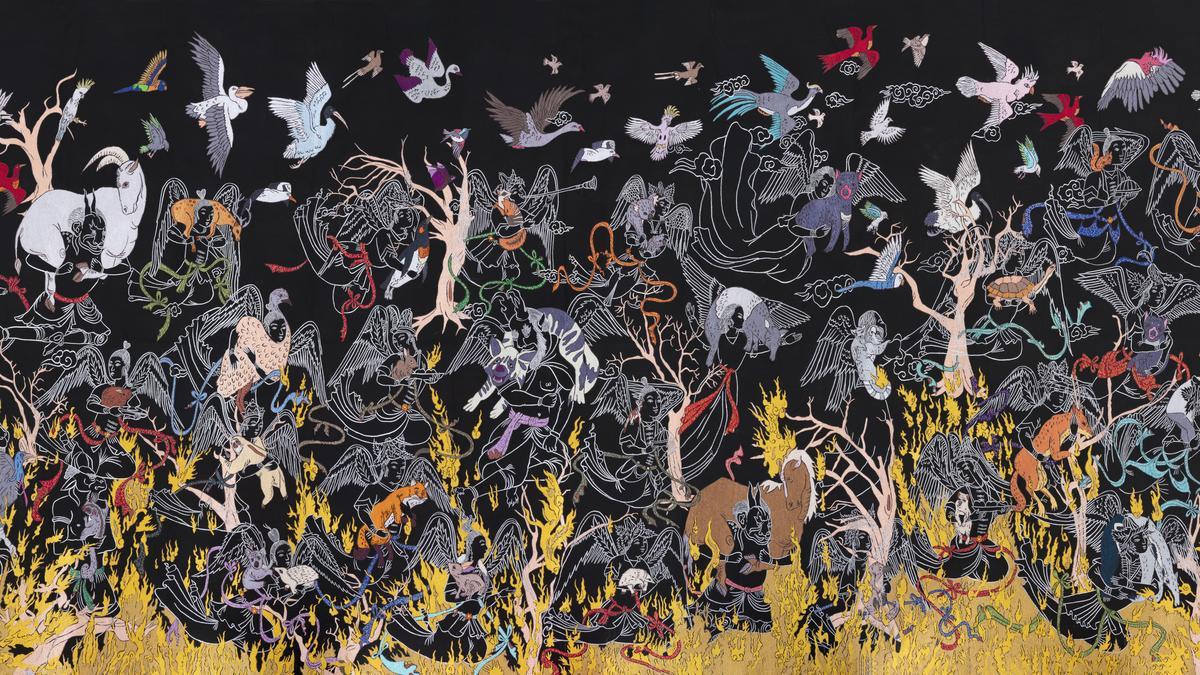
From the mundane to the myth, India’s identity is deeply intertwined with its textiles. They have nurtured craftsmanship, built communities, played a role in national revolutions, and paved the way to create world trade networks. Despite its rich history spanning centuries, textile art has garnered few enthusiasts within the broader arts community. However, textile-based shows today are striving to change this narrative.
Delhi Contemporary Art Week (DCAW), through its ongoing exhibition Threads That Bare, demonstrates how artists are drawing inspiration from India’s diverse textile traditions to craft multifaceted stories. This exhibition is timely, coinciding with a rising trend among curators and galleries in the subcontinent to showcase textile-based art. Notable exhibits include Vayan – The Art of Indian Brocades, curated by Mayank Mansingh Kaul at Delhi’s National Crafts Museum (2023), Sutr Santati at NGMA in Mumbai (2024), and Entwined – Edition 2 by Apparao Galleries.
Artist Natasha Das, traditionally trained in oils, transitioned to textiles after finding limitations in painting. Collaborating with weaving communities in Assam, she felt empowered to express vulnerability through textiles. “I shifted to memories and touch,” Das reflected. “When the pandemic hit, I closed my studio and started working with thread, layering it like oil. Textiles gave me a platform to feel, bond, and be present. My choice to use eri and muga silk in my works stemmed from this experience.”
Her piece Lahe Land 2 at DCAW (lahe lahe means ‘slowly’ in Assamese) is a tribute to Assam’s culture and landscape. “It is a visual map constructed from memory. I started by stitching and attaching, creating blocks of colour that are dense, and playful threads that connect these spaces,” Das explained. “The beautiful violet you see is the water hyacinth of Assam; the onion green eri silk is earthy. Each thread carries a memory and has a tale to tell.”
Threads That Bare features 14 artists, including Geeta Khandelwal and Khadim Ali. Khandelwal has dedicated decades to studying and practising quilt-making, and her displayed works meticulously recreate miniature royal garments from the 18th and 19th centuries using techniques such as hand-sewing and quilting. Ali, inspired by miniature and tapestry traditions, addresses themes of migration, loss, and trauma stemming from his experiences in Afghanistan and Pakistan. His monumental mixed-media work, I’m the Third Script 2, features intricate embroidery on cotton and silk, weaving childhood memories into the fabric.
Geeta Khandelwal’s miniature royal garments are a marvel of dedication and detail, where each stitch narrates a story of regality and heritage. Her decades-long journey through the medium has resulted in a body of work that acts as a timeless bridge to the past.
Khadim Ali’s powerful narratives emerge through the use of fine embroidery, where threads capture the painful legacy of his homeland’s conflict zones.
. His monumental mixed-media work, I’m the Third Script 2, stands as a testament to resilience and memory.
Curator-director Sharan Apparao of Apparao Galleries believes the current market for textile art is on the verge of expansion. “While the market may seem small currently, I believe it’s on the cusp of expansion with the backing of gallerists and collectors who genuinely appreciate and engage with textile art.”
The appeal of textile art lies in the material’s inherent adaptability, allowing artists to infuse it with various ideas, stories, identities, and emotions. Rajarshi Sengupta, an art historian and practitioner whose works were featured in the recent Entwined exhibition, emphasized this flexibility. His textile pieces, inspired by the kalamkari tradition, celebrate the coexistence of visual and sensory elements, shared histories, and future directions. Sengupta’s research into the history of kalam began with master carvers Kondra Gangadhar and Kondra Narsaiah in Andhra Pradesh. His work Catalogue Konda extends this exploration through ethnographic studies of Deccani textiles and their artisanal histories.
With grand exhibitions setting the stage, the question arises: what fuels the surge of interest in textile art? curator Mayank Mansingh Kaul perceives this trend as part of a global movement. “The field of contemporary visual arts has a tendency to draw from varied creative sources from time to time. We’ve seen this with architecture and film. Currently, textiles seem to be in the spotlight. However, those deeply embedded in the medium are cautious and hope this interest translates into long-term commercial viability and a robust market for fibre-based artists.”
Textiles are also being reconsidered from a gendered perspective. Traditionally categorized as ‘women’s craft,’ processes and styles associated with textiles have often been excluded from the fine arts canon. Artists, particularly women, are now asserting their agency and challenging these divides. Varunika Saraf, with her work The Longest Revolution, created using embroidery on a cotton textile, embodies this shift. “I am interested in women’s agency, women as makers of their own futures and agents of socio-political change,” she commented. “When I thought about the hopes, beliefs, and fears that I share with the women in my life, it seemed natural to embroider.”
Adding to this discourse, Kaul notes that the increased focus on textile-based art might stem from a renewed attention to women’s art practices. “Globally, curators have suggested that this current fixation with textile-based art emerges from an increased attention to women-based art practices. I believe there’s a greater interest in materiality and abstraction now. Or perhaps it’s natural given the long neglect of the field by the art world.”
The seventh edition of DCAW runs until September 4 at Bikaner House, inviting audiences to explore the rich tapestry of India’s textile art traditions and their modern interpretations.










